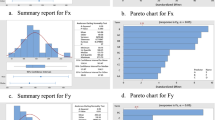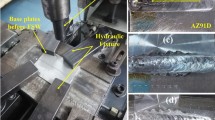Abstract
In CNC lead screw grinding, grinding allowance of screw groove is small. Tool deviation may lead to one side of the screw groove heavily grinded, while the other side of that not grinded or grinded not enough. Though the grinding wheel is right in the middle of the screw groove in the process of tool presetting for CNC lead screw grinding, tool deviation typically occurs in the subsequent grinding process. More specifically, the grinding wheel slightly deviates from the middle of the screw groove to the left or right of the screw groove.
In this work, the cause of tool deviation is analyzed as follows: the mutual following error of Z-axis and A-axis due to the differences between the mechanical and electrical characteristics. A method and formulas to address the tool deviation are proposed: The coordinates of A-axis and Z-axis in the grinding process are measured and recorded by the CNC system; then, the value of tool deviation caused by the mutual following error of Z-axis and A-axis is calculated. As a result, the grinding start position and the grinding end position are adjusted according to the tool deviation in the subsequent grinding process, so as to address the tool deviation issue.








Similar content being viewed by others
Data availability
We understand the data policy of the International Journal of Advanced Manufacturing Technology. We agree that all the data or software in our manuscript can be transparent for the public when it is published. We agree to follow the Springer Nature Research Data Policies.
References
Wang L, Chevy Chen Z, Li J, Sun J (2016) A novel approach to determination of wheel position and orientation for five-axis CNC flute grinding of end mills. Int J Adv Manuf Technol 84:2499–2514
Donghong Hu, Zhang L, Guo L, Wang P (2016) Tool presetting method for gear grinding based on the worst angles of tooth space edges. Int J Adv Manuf Technol 82:921–926
Jizhong L (2010) The Compensation and analysis of screw pitch error for CNC machining tools. Modular Machine Tool & Automatic Manufacturing Technique (Chinese) 2:98–101
Chen T, Tian X, Li Y (2013) Intelligent dimensional error pre-compensation in CNC grinding using iterative learning approach. Int J Adv Manuf Technol 67:1825–1832
Zhu S, Ding G, Qin S, Lei J, Zhuang L, Yan K (2012) Integrated geometric error modeling, identification and compensation of CNC machine tools. Int J Mach Tools Manuf 52(1):24–29
Wang C, Wiegers T, Vergeest JSM (2011) An implementation of intelligent CNC machine tools. Appl Mech Mater 1082:557–561
Trmal GJ, Zhu CB, Midha PS (1992) An expert system for grinding process optimization. J Mater Process Technol 33:507–517
Okino F, Murai Y (1995) Control apparatus and control method for machine tools using fuzzy reasoning. United States Patent 5402354. 28 Mar 1995
Warren Liao T, Chen LJ (1994) A neural network approach for grinding processes: modeling and optimization. Int J Mach Tools Manuf 34(7):919–937
Wang Z, Willet P, DeAguiar PR, Webster J (2001) Neural network detection of grinding burn from acoustic emission. Int J Mach Tools Manuf 41(2):283–309
Author information
Authors and Affiliations
Contributions
We declare that all the authors have made contribution on this manuscript and their names have been listed by order of importance and contribution.
Corresponding authors
Ethics declarations
Ethical approval
This paper is submitted to the International Journal of Advanced Manufacturing Technology for the first time. All the authors have fully understood the rules of COPE. We hereby declare that this manuscript is original. Neither the entire paper nor any part of this paper has been submitted or published elsewhere in any form or language. We ensure the integrity of our work and all the research results are based on the experimental facts. No data, text, or theories by others are presented in the manuscript as if they were the author’s own.
Consent to participate
All the authors have read this manuscript. They have fully understood the policy of the International Journal of Advanced Manufacturing Technology, and agreed to this submission.
Consent to publication
Depending on the ownership of the journal and its policies, all the authors will transfer a copyright form of the article to the Publisher.
Competing interests
The authors declare no competing interests.
Additional information
Publisher's Note
Springer Nature remains neutral with regard to jurisdictional claims in published maps and institutional affiliations.
Rights and permissions
About this article
Cite this article
Hu, D., Wang, K., Zhang, L. et al. Research on tool presetting and tool deviation in CNC lead screw grinding process. Int J Adv Manuf Technol 121, 827–835 (2022). https://doi.org/10.1007/s00170-022-09357-z
Received:
Accepted:
Published:
Issue Date:
DOI: https://doi.org/10.1007/s00170-022-09357-z




